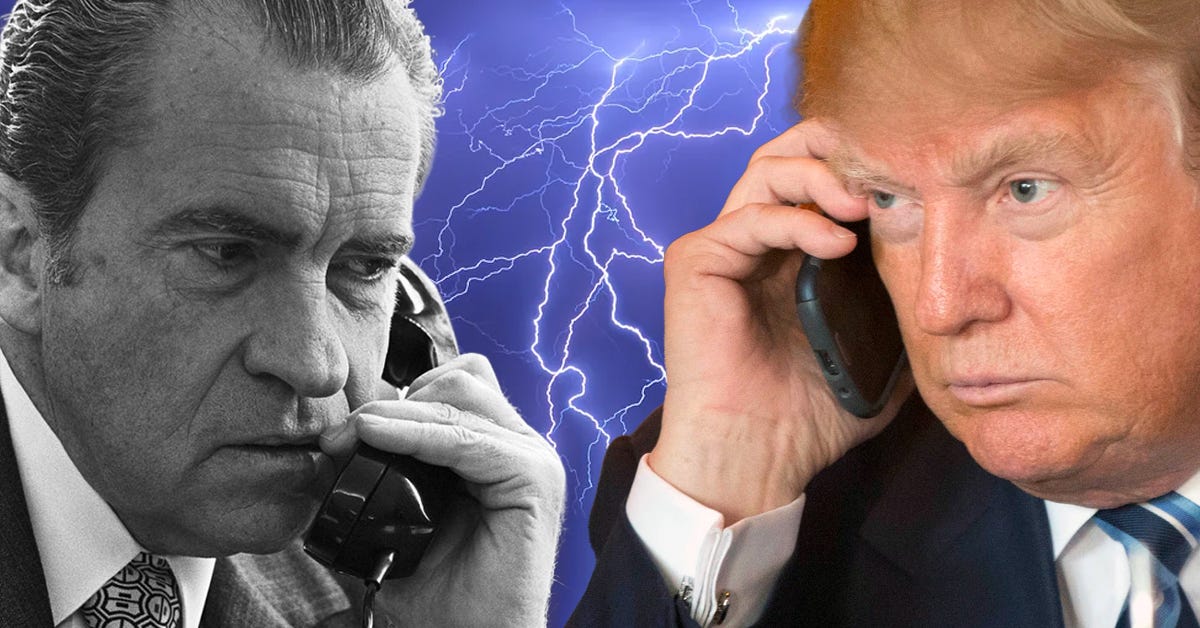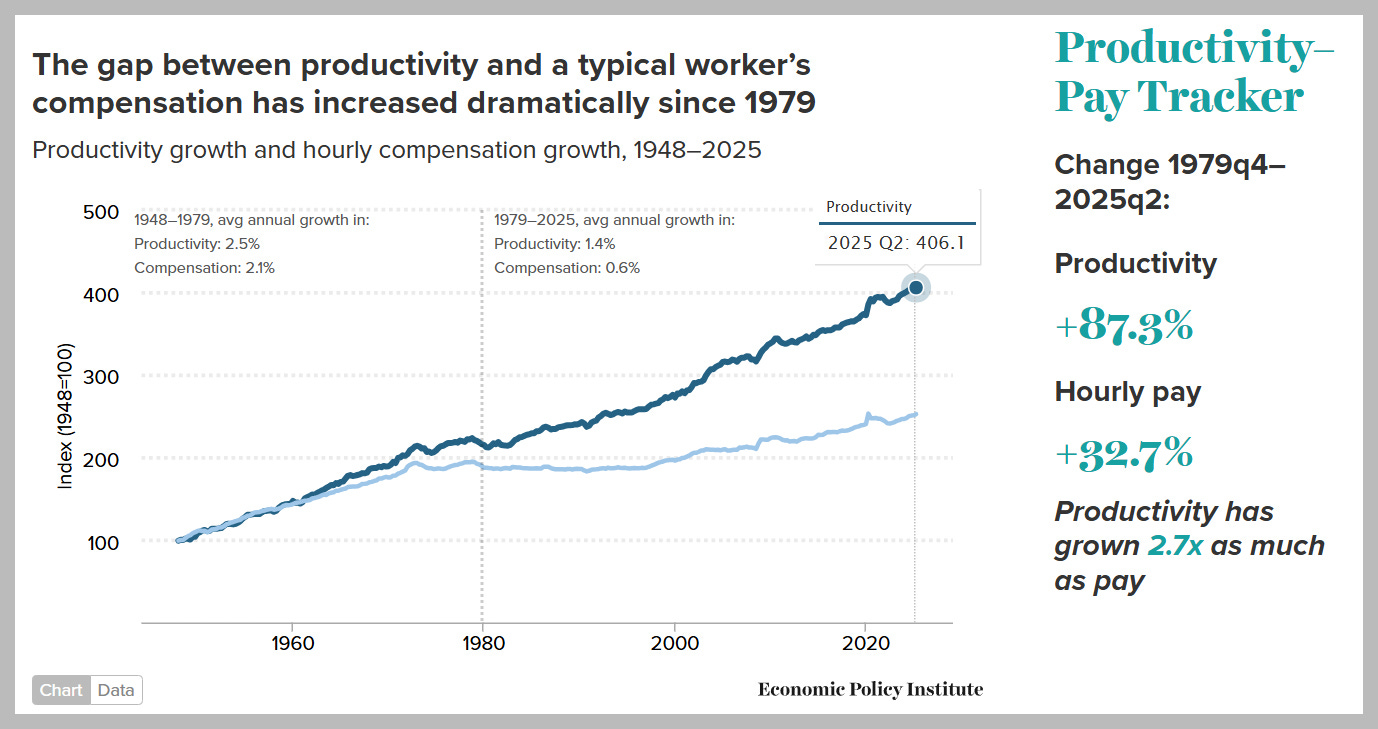54+ Year Scheme To Steal Your Wages
How a Conservative Project Created Today's Pay Inequality
If you have ever felt like the economy is broken, you are not imagining it. A popular website, WTF Happened In 1971?, captures this feeling with dozens of stark graphs.
The charts all show the same thing: for decades after World War II, productivity and worker pay rose together. Americans created more value, and they shared in the prosperity.
Then, around 1971, the lines diverged. Productivity continued to climb, but real wages for average workers flatlined.
This divergence is known as the “Great Decoupling.” It is the central economic mystery of our time.
For fifty years, Americans have been working harder and more efficiently, but their paychecks have barely budged. Meanwhile, income for the top one percent has exploded.
This was not an accident. It was the result of a profound economic shift combined with a deliberate, decades long political project.
A Year of Two Shocks
The year 1971 was a breaking point. Two events that August set the stage for our modern era.
First, President Richard Nixon unilaterally “closed the gold window,” ending the U.S. dollar’s convertibility to gold. This decision, known as the “Nixon Shock,” severed the dollar from its last tie to a physical asset. It ushered in our current era of pure fiat currency.
This new system allowed for massive expansions of debt and credit, fundamentally changing the rules of the global economy.
Just days later, a second, more secretive event occurred. Corporate lawyer Lewis F. Powell Jr., soon to be a Supreme Court Justice, wrote a confidential memo for the U.S. Chamber of Commerce.
This document, known as the “Powell Memo,” was the ideological blueprint for a corporate counter revolution.
Powell argued that the “American free enterprise system” was under attack from progressives, consumer advocates, and unions. He outlined a long term strategy to seize back political and cultural power.
The Powell Memo: A Corporate Battle Plan
The Powell Memo was a call to arms for American business. He argued that corporations needed to get serious about politics. He wrote that “political power must be assiduously cultivated” and used “aggressively.”
Powell was not just talking about lobbying. He detailed a comprehensive plan to reshape American society in the interest of capital.
His strategy was methodical. He called for funding pro business scholars and think tanks to challenge academia. He wanted to “monitor” the media for anti-business bias and fund massive public relations campaigns.
Most importantly, he urged corporations to fund a new legal movement. This movement would “aggressively” use the courts to fight government regulations and advance corporate interests.
The memo was a stunning success. It galvanized the business community and led to the creation of powerful new institutions, including the Business Roundtable and conservative think tanks that would soon dominate Washington.
From Memo to Machine: The GOP and Corporate Power
The Powell Memo provided the playbook. The Republican Party became its most dedicated player. Beginning with the Reagan administration, the memo’s ideas were systematically put into practice.
This “Reagan Revolution” was built on two core pillars advocated by this new corporate machine: massive tax cuts and deregulation.
Tax cuts, especially for corporations and the highest earners, were sold as a way to boost investment. In practice, they largely funneled the gains from rising productivity directly to shareholders and executives.
Simultaneously, deregulation and aggressive anti-union policies, like Reagan’s breaking of the PATCO air traffic controllers strike, began to dismantle the power of organized labor.
Without unions to bargain for them, workers lost their primary mechanism for demanding their share of the profits.
Subsequent GOP lawmakers and presidents have consistently followed this script, from the Bush tax cuts to the Trump tax cuts of 2017, all while appointing judges sympathetic to this corporate worldview.
A growing collection of media outlets like The Nation have reported that the Powell Memo helped create Project 2025, Trump’s blueprint for dismantling the federal government and undermining American democracy.
🔥 Join 16,000+ members. Subscribe for unflinching legal truth! Your support keeps this space open and ad-free. 🔥
The Supreme Court and the Legal War on Wages
Powell’s most enduring legacy may be his call to weaponize the legal system. The long term project to place conservative, pro business judges on the federal bench, especially on the Supreme Court, has paid enormous dividends for corporate interests.
SCOTUS has become a powerful engine for increasing pay inequality.
The 2010 Citizens United decision is a prime example. The court ruled that corporate spending on elections is a form of free speech, opening the floodgates for unlimited dark money in politics.
This allows corporations to directly fund the politicians who will cut their taxes and deregulate their industries.
More recently, in Janus v. AFSCME (2018), the court’s conservative majority dealt a severe blow to public sector unions.
This decision further weakened organized labor, which is the single most effective check on corporate power and a key driver of higher wages for all workers.
These are not isolated cases. They are the fulfillment of Powell’s 1971 vision for a judiciary that champions corporate interests over those of average citizens.
The Legacy: Today’s Landscape of Inequality
Today, we are living in the world the Powell Memo helped build. The charts from WTF Happened are not a mystery. They are a report card on a 50 year political project.
The decoupling of wages from productivity is the direct result of deliberate policy choices championed by GOP lawmakers, presidents, and a sympathetic Supreme Court.
When corporations can spend unlimited money on politics, they get the policies they want. When those policies include tax cuts for the wealthy, deregulation, and the destruction of unions, the result is predictable.
Under this model, all the economic value created by a more productive workforce flows to the top. This leaves average workers with stagnant wages, rising debt, and a deep seated feeling that the game is rigged against them. That feeling is correct.
Today’s historic pay inequality is not a bug in the system; it is the system’s intended feature.






Those of us who voted against Reagan saw it coming.
It's time to overturn Citizens United. Let's get dark money out of politics!
Great information. Thank you.